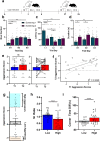Quantitative standardization of resident mouse behavior for studies of aggression and social defeat
- PMID: 33941861
- PMCID: PMC8280187
- DOI: 10.1038/s41386-021-01018-1
Quantitative standardization of resident mouse behavior for studies of aggression and social defeat
Abstract
Territorial reactive aggression in mice is used to study the biology of aggression-related behavior and is also a critical component of procedures used to study mood disorders, such as chronic social defeat stress. However, quantifying mouse aggression in a systematic, representative, and easily adoptable way that allows direct comparison between cohorts within or between studies remains a challenge. Here, we propose a structural equation modeling approach to quantify aggression observed during the resident-intruder procedure. Using data for 658 sexually experienced CD-1 male mice generated by three research groups across three institutions over a 10-year period, we developed a higher-order confirmatory factor model wherein the combined contributions of latency to the first attack, number of attack bouts, and average attack duration on each trial day (easily observable metrics that require no specialized equipment) are used to quantify individual differences in aggression. We call our final model the Mouse Aggression Detector (MAD) model. Correlation analyses between MAD model factors estimated from multiple large datasets demonstrate generalizability of this measurement approach, and we further establish the stability of aggression scores across time within cohorts and demonstrate the utility of MAD for selecting aggressors which will generate a susceptible phenotype in social defeat experiments. Thus, this novel aggression scoring technique offers a systematic, high-throughput approach for aggressor selection in chronic social defeat stress studies and a more consistent and accurate study of mouse aggression itself.
© 2021. The Author(s), under exclusive licence to American College of Neuropsychopharmacology.
Figures





References
-
- Miczek KA, Faccidomo S, de Almeida RMM, Bannai M, Fish EW, Debold JF. Escalated Aggressive Behavior: New Pharmacotherapeutic Approaches and Opportunities. In: Devine J, editor Youth Violence: Scientific Approaches to Prevention. New York, NY, US: New York Academy of Sciences; 2004. p. 336–55. - PubMed
Publication types
MeSH terms
Grants and funding
LinkOut - more resources
Full Text Sources
Other Literature Sources
Miscellaneous

